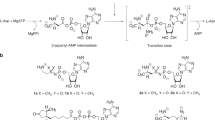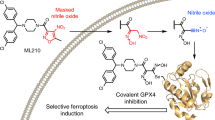Abstract
A systematically diversified set of peptide analogs of the reaction product of glutathione with an electrophilic substrate have been tested as isozyme-specific inhibitors of human glutathione-S-transferase (GST). The potency of the best of the inhibitors is in the 0.5 to 20 micromolar range, with kinetics indicative of competitive inhibition with glutathione at the active site. The specificity observed among three recombinant-derived GST isozymes at both low and high potency ranged from negligible to high (at least 20-fold over the next most sensitive isozyme). These results define a novel strategy for the design of drugs targeting cells with elevated levels of particular GST isozymes, such as tumor cells for which elevated levels of GST are believed to be an important cause of chemotherapeutic drug resistance.
Similar content being viewed by others
Abbreviations
- GSH:
-
glutathione
- GST:
-
glutathione-S-transferase
- CDNB:
-
1-chloro-2,4-dinitrobenzene
- phegly:
-
S(+)phenylglycine
- β-ala:
-
3-aminopropionic acid
- 4-ABu:
-
4-aminobutyric acid
- QSAR:
-
quantitative structure/activity relationship
- IC50 :
-
concentration required for 50% inhibition
References
Adang AEP, Meyer D, Brussee J, Gen A van der, Ketterer B, Mulder GJ (1989) Interaction of rat glutathione-S-transferases 7-7 and 8-8 with γ-glutamyl-or glycyl-modified glutathione analogs. Biochem J 264: 759–764
Adang AEP, Brussee J, Gen A van der, Mulder GJ (1990) The glutathione-binding site in glutathione-S-transferases. Biochem J 269: 47–54
Arrick BA, Nathan CF (1984) Glutathione metabolism as a determinant of therapeutic efficacy: a review. Cancer Res 44: 4224–4232
Benedek K, Várkonyi A, Hughes B, Zabel K, Kauvar LM (1992) Paralog chromatography: sorbent families for protein separations. J Chromatogr 627: 51–61
Castro VM, Söderström M, Carlberg I, Widersten M, Platz A, Mannervik B (1990) Differences among human tumor cell lines in the expression of glutathione transferases and other glutathione-linked enzymes. Carcinogenesis 11: 1569–1576
Castro VM, Kelley MK, Engqvist-Goldstin Å, Kauvar LM (1993) Glutathione analog sorbents selectively bind glutathione-S-transferases isozymes. Biochem J 292: 371–377
Chasseaud IF (1979) The role of glutathione and glutathione-S-transferases in the metabolism of chemical carcinogens and other electrophilic agents. Adv Cancer Res 29: 175–274
Cheung PYK, Kauvar LM, Engqvist-Goldstein AE, Ambler SM, Karu AE, Ramos LS (1993) Harnessing immunochemical cross-reactivity: use of pattern recognition to classify molecular analogs. Anal Chim Acta (in press)
Clapper ML, Hoffman SJ, Tew KD (1990) Sensitization of human colon tumor xenografts toL-phenylalanine mustard using ethacrynic acid. J Cell Pharmacol 1: 71–78
Cole SPC, Downes HF, Mirski SEL, Clements DJ (1990) Alterations in glutathione and glutathione-related enzymes in a multi-drug resistant small cell lung cancer cell line. Med Pharmacol 37: 192–197
Coles B, Ketterer B (1990) The role of glutathione and glutathione transferases in chemical carcinogenesis. CRC Crit Rev Biochem 25: 47–70
Fodor SPA, Read JL, Pirrung MC, Stryer, L, Lu AT, Solas D (1991) Light-directed, spatially adressable parallel chemical synthesis. Science 251: 767–773
Ford JM, Hait WN, Matlin SA, Benz CC (1991) Modulation of resistance to alkylating agents in cancer cells by gossypol enantiomers. Cancer Lett 56: 85–94
Geysen HM, Meleon RH, Barteling SJ (1984) Use of a peptide synthesis to probe viral antigens for epitopes to a resolution of a single amino acid. Proc Natl Acad Sci USA 81: 3998–4002
Hall A, Robson CN, Hickson ID, Harris AL, Proctor SJ, Cattan AR (1989) Possible role of inhibition of glutathione-S-transferase in the partial reversal of chlroambucil resistance by indomethacin in a Chinese hamster ovary cell line. Cancer Res 49: 6265–6268
Hansch C, Klein TE (1986) Molecular graphics and QSAR in the study of enzyme ligand interactions. Acc Chem Res 19: 392–400
Hansson J, Berhame K, Castro VM, Jungelius U, Mannervik B, Ringborg U (1991) Sensitization of human melanoma cells to the cytotoxic effect of melphalan by the glutathione transferase inhibitor ethacrynic acid. Cancer Res 51: 94–98
Hayes PC, Bouchier IAD, Beckett GJ (1991) Glutathione-S-transferase in humans in health and disease. Gut 32: 813–818
Houghten RA, Appel JR, Blondelle SE, Cuervo JH, Dooley CT, Pinilla C (1992) The use of synthetic peptide combinatorial libraries for the identification of bioactive peptides. BioTechniques 13: 412–421
Howie AF, Forrester LM, Glancey MJ, Schlager JJ, Powis G, Beckett GJ, Hayes JD, Wolf CR (1990) Glutathione-S-transferase and glutathione peroxidase expression in normal and tumor human tissues. Carcinogenesis 11: 451–455
Kauvar LM (1992) Method to identify analyte-binding peptides. Patent 5, 133, 866, United States Patent Office, Washington, D. C.
Kramer RA, Zakher J, Kim G (1988) Role of the glutathione redox cycle in acquired and de novo multidrug resistance Science 241: 694–697
Larson A (ed) (1986) Functions of glutathione: biochemical, physiological, toxocological, and clinical aspects, Raven, New York
Lyttle MT, Aaron D, Hocker MD, Hughes BR (1992) Construction of affinity sorbents utilizing glutathione analogs. Peptide Res 5: 336–342
Mannervik B, Danielson UH (1988) Glutathione — structure and catalytic activity. CRC Crit Rev Biochem 23: 283–337
Mannervik B, Guthenberg C (1981) Glutathione transferase (human placenta). Methods Enzymol 77: 231–235
Mannervik B, Alin P, Guthenberg C, Jensson H, Tahir MK, Warholm M, Jornvall H (1985) Identification of three classes of cytosolic glutathione transferase common to several mammalian species: correlation between structural data and enzymatic properties. Proc Natl Acad Sci USA 82: 7202–7206
Mannervik B, Castro VM, Danielson UH, Tahir MK, Hansson J, Ringborg U (1987) Expression of class pi glutathione transferase in human malignant melanoma cells. Carcinogenesis 8: 1929–1932
Mannervik B, Awash YC, Board PG, Hayes JD, Di Illio C, Ketterer B, Listowsky I, Morgenstern R, Muramatsu M, Pearson WR, Pickett CB, Sato K, Widersten M, Wolf CR (1992) Nomenclature for human glutathione transferases. Biochem J 282: 305–308
Manoharan TH, Gulick AM, Reinemer P, Dirr HW, Huber R, Fahl WE (1992) Mutational substitution of residues implicated by crystal structure in binding the substrate glutathione to human glutathione S-transferase pi. J Mol Biol 226: 319–322
Mantle TJ, Pickett CB, Hayes JD (eds) (1987) Glutathione-S-transferase and carcinogenesis. Taylor and Frances, London
Massart DL, Vandeginste BGM, Deming SN, Michotte Y, Kaufman L (1988) Chemometrics: a textbook. Elsevier, Amsterdam
Moscow JA, Fairchild CR, Madden MI, Ransom DT, Weand HS, O'Brien EE, Poplack DG, Cossman J, Meyers CE, Cowan KH (1989) Expression of anionic glutathione-S-transferase and P-glycoprotein genes in human tissues and tumors. Cancer Res 1422–1428
O'Dwyer PJ, La Creta F, Nash S, Tinsley PW, Schilder R, Clapper ML, Tew KD, Panting L Litwin S, Comis RL (1991) Phase I study of thiotepa in combination with the glutathione transferase inhibitor ethacrynic acid. Cancer Res 51: 6059–6065
Penington CJ, Rule GS (1992) Mapping the substrate-binding site of a human class mu glutathione transferase using nuclear magnetic resonance spectroscopy. Biochemistry 31: 2912–2920
Pickett CB, Lu AYH (1989) Glutathione-S-transferase: structure and enzymatic activity. Annu Rev Biochem 58: 694–697
Puchalski RB, Fahl WE (1990) Expression of recombinant glutathione-S-transferase π, Ya or Yb confers resistance to alkylating agents. Proc Natl Acad Sci USA 87: 2443–2447
Reinemer P, Dirr HW, Ladenstein R, Huber R, Lo Bello M, Federici G, Parker MW (1992) Three-dimensional structure of class pi glutathione-S-transferase from human placenta in complex with S-hexylglutathione at 2.8 A resolution. J Mol Biol 227: 214–226
Ross D (1988) Glutathione, free-radicals, and chemotherapeutic agents: mechanisms of free-radical induced toxicity and glutathione-dependent protection. Pharmacol Ther 37: 231–249
Segel IH (1976) Enzymes in biochemical calculations. John Wiley & Sons, New York, pp 204–323
Seidegard J, Pero RW, Martowitz MM (1990) Isoenzymes of glutathione-S-transferase (class mu) as a marker for the susceptibility to lung cancer: a follow-up study. Carcinogenesis 11: 33–36
Smith MT, Evans C, Doane-Setzer P, Castro VM, Tahir MK, Mannervik B (1989) Denitrosation of 1,3-bis(2-chloroethyl)-1-nitrosourea by class mu glutathione transferases and its role in cellular resistance in rat brain tumor cells. Cancer Res 49: 2621–2625
Tew KD, Bomber AM, Hoffman JJ (eds) (1988) Ethacrynic acid and piriprost as enhancers of cytotoxicity in drug-resistant and-sensitive cell lines. Cancer Res 48: 3622–3625
Tew KD, Schisselbauer JC, Clapper ML, Kuzmich S (1990) Glutathione-S-transferases and resistance to alkylating agents. In: Hayes JD, Pickett CB, Mantle TJ (eds) Glutathione-S-transferase and drug resistance. Taylor and Francis, London, pp 309–317
Vorachek WR, Pearson WR, Rule GS (1991) Cloning, expression and characterization of a class-mu glutathione transferase from human muscle, the product of the GST 4 locus. Proc Natl Acad Sci USA 88: 4443–4447
Wellner VP, Anderson ME, Puir RN, Jensen GL, Meister A (1984) Radioprotection by glutathione ester: transport of glutathione ester into human lymphoid cells and fibroblasts. Proc Natl Acad Sci USA 81: 4732–4735
Xinhua J, Zhang P, Armstrong RN, Gilliland GL (1992) The three-dimensional structure of a glutathione-S-transferase from the mu class. Biochemistry 31: 10169–10184
Zhang P, Suxing L, Shan S, Xinhua J, Gilliland GL, Armstrong RN (1992) Modular mutagenesis of exons 1, 2, and 8 of a glutathione-S-transferase from the mu class. Biochemistry 31: 10185–10193
Author information
Authors and Affiliations
Rights and permissions
About this article
Cite this article
Flatgaard, J.E., Bauer, K.E. & Kauvar, L.M. Isozyme specificity of novel glutathione-S-transferase inhibitors. Cancer Chemother. Pharmacol. 33, 63–70 (1993). https://doi.org/10.1007/BF00686025
Received:
Accepted:
Issue Date:
DOI: https://doi.org/10.1007/BF00686025




